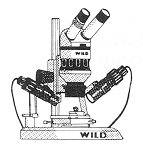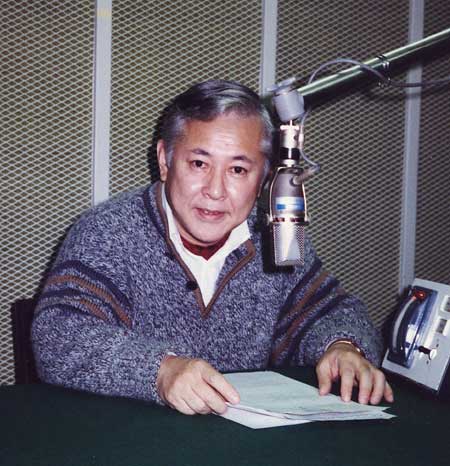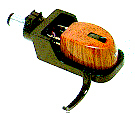McIntosh Phonograph Cartridges and Tonearm
A History
By Roger Russell
Copyright
1996-2005 by Roger Russell
All rights reserved
No portion of this site may be reproduced in whole or in part
without written permission of the author.
![]()
 Gordon Gow
had an intense interest in phonograph cartridges and tonearms. He encouraged
dealers to be properly equipped to check and install phonograph cartridges for
customers. Not all cartridge styli are properly oriented as received from the
manufacturer. As a result several dealers invest in a recommended Wild-Heerbrug
M5 Stereo Microscope and collimates light sources that can adequately show
stylus condition and orientation. This microscope system is about $4000. The
cartridge is placed on its back and held with some "putty" to a small
turntable in the viewing area. By placing the stylus at the center of the field
of vision, the turntable can be slowly rotated by hand and any signs of wear
can easily be seen. Proper orientation can also be verified for an elliptical
stylus.
Gordon Gow
had an intense interest in phonograph cartridges and tonearms. He encouraged
dealers to be properly equipped to check and install phonograph cartridges for
customers. Not all cartridge styli are properly oriented as received from the
manufacturer. As a result several dealers invest in a recommended Wild-Heerbrug
M5 Stereo Microscope and collimates light sources that can adequately show
stylus condition and orientation. This microscope system is about $4000. The
cartridge is placed on its back and held with some "putty" to a small
turntable in the viewing area. By placing the stylus at the center of the field
of vision, the turntable can be slowly rotated by hand and any signs of wear
can easily be seen. Proper orientation can also be verified for an elliptical
stylus.
Records are a primary source of program material for us to use in evaluating speakers. Cartridges are a very important factor in how the speakers appeared to sound. Gordon kept us supplied with a variety of the latest cartridges to test and use. We evaluated them using the CBS test record series and also the Bruel & Kjaer test records. We also used the latest Thorens turntables and SME tonearms. As cartridges improved, we were constantly changing and updating.
![]()
McIntosh Cartridges
 Gordon was
a good friend of Okie Sugano (photo) who was a well-known critic, reviewer and
writer in Japanese audio. As a schoolboy, Okie had read a technical article
about the McIntosh Unity Coupled circuit in a Japanese technical audio magazine
and had seen the McIntosh the 50W2 amplifier. He was very impressed. Later, he
had seen the MC60 and MC240 in a dealer's window. The first system he heard
using a McIntosh amplifier was the MC275 driving Altec A5's.
Gordon was
a good friend of Okie Sugano (photo) who was a well-known critic, reviewer and
writer in Japanese audio. As a schoolboy, Okie had read a technical article
about the McIntosh Unity Coupled circuit in a Japanese technical audio magazine
and had seen the McIntosh the 50W2 amplifier. He was very impressed. Later, he
had seen the MC60 and MC240 in a dealer's window. The first system he heard
using a McIntosh amplifier was the MC275 driving Altec A5's.
He wanted very much to meet the people who designed this fantastic equipment, but it was very difficult to go to the USA at that time. He was finally able to travel to Binghamton for the first time in 1967. At last, he was able to meet Gordon Gow and Frank McIntosh. For him, this trip was like a dream come true.
 Encouraged by
Okie and the need to gain more understanding of the Japanese market, Gordon
made his first visit to Japan in 1978. Gordon was interested in a cartridge for
McIntosh and learned of the Brier moving coil cartridge made by the Mark
Corporation in Japan. Mr. Imamura, who was president of the company, was an old
friend of both Okie Sugano and Ike Hattori. Okie's wife handcrafted the brier
wood housings for the cartridges. Each housing was a unique work of art, as no
two were exactly alike. She was a smoking pipe carver at that time and had
studied woodcarving in Denmark with a very famous artist named Anne Julie
Rasmussen.
Encouraged by
Okie and the need to gain more understanding of the Japanese market, Gordon
made his first visit to Japan in 1978. Gordon was interested in a cartridge for
McIntosh and learned of the Brier moving coil cartridge made by the Mark
Corporation in Japan. Mr. Imamura, who was president of the company, was an old
friend of both Okie Sugano and Ike Hattori. Okie's wife handcrafted the brier
wood housings for the cartridges. Each housing was a unique work of art, as no
two were exactly alike. She was a smoking pipe carver at that time and had
studied woodcarving in Denmark with a very famous artist named Anne Julie
Rasmussen.
Mr. Imamura's company also made other cartridges known as the Goldbug, Medusa and Clement. They were essentially the same, but had various armature lengths and styli resulting in slight differences in sound. The primary source of income for his company was audio meters and turntable systems. The cartridges were more of a hobby.
 Okie
Sugano did all the planning, designing and naming of the cartridges as well as
being responsible for the sound. The moving-coil transducer mechanism was
designed and made by Mr. Imamura.
Okie
Sugano did all the planning, designing and naming of the cartridges as well as
being responsible for the sound. The moving-coil transducer mechanism was
designed and made by Mr. Imamura.
I became involved with evaluating these cartridges at McIntosh, and even making recommendations for a few changes. In 1984 the Mark Corporation produced two cartridges for McIntosh, the MCC800 and the MCC1000. Unlike many moving coil cartridges, these did not have a peak in the response at the high end that normally emphasized intermodulation products. The brier housing was not used for the McIntosh cartridges in order to reduce mass.
The coils were wound directly on the stylus cantilever. Consequently, the styli were not user-replaceable. The cartridge had to be returned to the factory for replacement and correct alignment. A new response/separation chart was made for the new assembly.
McIntosh also introduced the MCP-1 preamp designed specifically for moving coil cartridges.
At this time CD's were gaining more in sales. The cartridges were available for only a short time and very few were sold. The company, Mark Corporation, has since gone out of business.
![]()
McIntosh Tonearm
 In the late
1970's, Bob Graham, an engineer at MIT, became acquainted with Gordon and had a
tonearm that he wanted to market. Gordon was very interested. I became involved
in evaluating and demonstrating this potential McIntosh product. It was a
unique silicon damped unipivot construction. The unipivot bearing was made of
tungsten carbide. Bob had created an outstanding design with many innovative
ideas and features. Gordon assisted in getting a patent for Bob Graham, a bill
of materials was generated and a few McIntosh prototype arms were constructed.
In the late
1970's, Bob Graham, an engineer at MIT, became acquainted with Gordon and had a
tonearm that he wanted to market. Gordon was very interested. I became involved
in evaluating and demonstrating this potential McIntosh product. It was a
unique silicon damped unipivot construction. The unipivot bearing was made of
tungsten carbide. Bob had created an outstanding design with many innovative
ideas and features. Gordon assisted in getting a patent for Bob Graham, a bill
of materials was generated and a few McIntosh prototype arms were constructed.
Again, CD's were growing in popularity and a decision was made by management not to market the tonearm. Despite this turn of events, Bob decided to go ahead market his invention by himself under the name of Graham Engineering Inc. He continued to make improvements, and today it is recognized as one of the world's finest tonearms.
![]()
|
About This Site |
||
|
|
More text and pictures about McIntosh will be added as my research continues. Any comments, corrections, or additions are welcome. |
|
|
|
Created by Roger Russell |
|